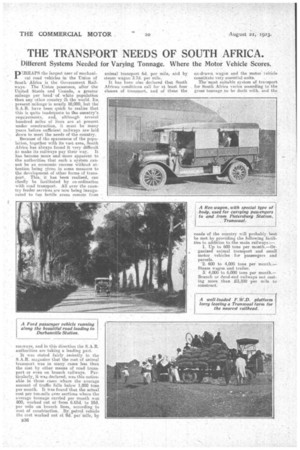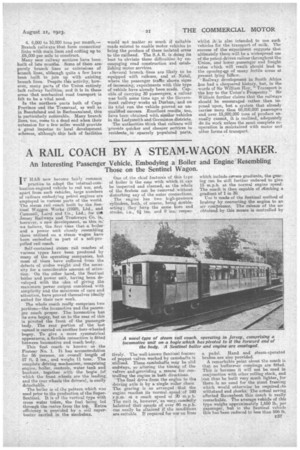THE TRANSPORT NEEDS OF SOUTH AFRICA.
Page 20

Page 21

If you've noticed an error in this article please click here to report it so we can fix it.
Different Systems Needed for Varying Tonnage. Where the Motor Vehicle Scores.
P__ the largest user of riled-midcal road vehicles in the Union of South Africa is the Government Railways.. The Union possesses, after the United States and Canada, a greater Mileage per head• of. white population than any other country rft. the world. Its present mileage -is nearly 10,000, but the S.A.R. have been quick to realize that this is quite inadequate to Ciao oountry's requirements, and, although several hundred miles of lines are at present under construction, it must be many years before sufficient railways are laid down to meet the needs of the country.
Because of the sparseness of the population, together with its vast area, South Africa, has always found it very difficult make its railways pay their way. It has become more and more apparent to the authorities that such a system canuot be art economic success without attention being given in some measure to the development of other forms of trans.Port. This; it has been realised, can chiefly be facilitated by co-ordination with road transport. All over the country feeder services are now being inaugurated to tap fertile areas remote from railways, and in this direction the S.A.R. authorities are taking a leading part.
It was stated fairly ree'ently in the S.A.R. magazine that the cost of animal transportwas in many cases less than the cost by other means of road transport or even on branch railways. Particularly, it was declared, was this noticeable in those cases where the average amount of traffic falls below 1.000 tons per month. It was found that the actual cost per tonanile over sections where the average tonnage carried per month was 800, worked out at. from 6.65d. to 10d. per mile on branch lines, according to cost of construct-ion. By petrol vehicle the cost worked out at 9d. per mile, by
B36
animal transport 6d. per niile, and by steam wagon 3.7d. per mile.
It has been also declared that South African conditions call for at: least four classes of transport, and of these the ox-drawn, wagon and the -motor vehicle constitute very essential units. .. • The'Biost suitable system of transport for South,Africa varies according to the grosstannage to be dealt with, and the
needs of the country will probably best he met by providing the following facilities in addition to..the main railways :—, 1. Up to 600 tons per montb.—Organized animal transport and small motor vehicles for passengers and parcels.
2. 600 to 4,000 tons per month.— Steam wagon and trailer.
3: 4,000to 6,000 tons per month.— Branch or dead-end railwa.ys not costing more than £3,600 -per mile to construct. 4.6,000 to 10,000 tons per month.— Branch railways that form connecting lin-ks with main lines and costing up to 26,000 per mile to construct.
Many new railway sections have been built of late months. Some of them are' purely branch lines or exteneimm of branch lines, although quite a few have been built to join up with existing, branch lines. Despite this activity, however, many parts of the Union entirely lack railway facilities, and it is in these areas that mechanical road transport is felt to be a vital need.
In the northern parts both of Cape Province and the Transvaal, as well as in Basutoland and in Bechuanaland, this is particularly noticeable. Many branch lines, too, come to a dead end when their extension for a few miles would provide a great impetus to local development schemes, although this lack of facilities would not matter so much if suitable roads existed to enable motor vehicles to bring the produce of these isolated areas to the railhead. The S.A.R. is doing its best to obviate these difficulties by encouraging road construction and establishing motor services.
.Several branch -lines are likely to be 'equipped with railcars, and at Natal, where the passenger traffic shows signs of increasing, experiments with this type of vehicle have already been made. Capable of carrying 30 passengers, a railcar was built some time ago at the Government railWay works at Durb.an, and on its trial run the vehicle proved an unqualified success. Excellent results, too, have been obtained with similar vehicles in the Ladysmith and Germiston districts.
The authorities think that railcars will 'provide quicker and cheaper services to residenta in sparsely populated parts, whilst it also intended to use such vehicles for the transport of milk. The success of the experiment suggests that ultimately there will be a widespread use of the petrol-driven railca'r throughout the Union, and lower passenger and freight rates which will result should lead to the openingaw of many fertile areas at present lying fallow.
• --Railway development in South Africa has had a chequered history, but, in the words of Sir William Hoy, "Transport is the key to the Union's Prosperity." Sir William further claims that the railways should be encouraged rather than imposed upon, but a. system that already carries more than 60,000,000 passengers and over 15,000,000 tons of produce annually cannot, it is realized, adequately do its work unless the most complete cooperation is maintained with motor and other forms of transport.




























